Agroecology & Permaculture
A conceptual overview of concrete practices that could better align agriculture and nature.
Now at the peak of Spring, it’s time to float the garden of greens onto the pond and hope that the koi don’t find a way to devour it all. Across the water, the apple and cherry trees are blossoming and I wonder whether I’ll beat the squirrels to anything this year. At least I’ll be able to harvest most of the herbs growing around their trunks. I’m just a novice in agroecology techniques like aquaponics and agroforestry, but I can’t escape the idea that agroecology may be a wiser solution to agricultural issues than anything I saw in four years as an agrifoodtech venture capitalist.
Though, I still believe that advanced technology has an important role in the marketplace of solutions. The best path ahead probably includes an integration of both agroecological wisdom (often indigenous) and technologies like AI, farm robotics, vertical farming, and gene editing. So, here’s my attempt to provide the highest-level overview of the most practical elements in agroecology, to complement many previous posts on technology.
Industrial Monocultures
Agriculture is the foundation of society, thanks to powerful industrial technologies like tractors, chemical fertilizers, and crop genetics. This has led to a pervasive specialization in optimized “staple crops,” with 83% of all harvested food calories coming from only 10 crops. Food production looks more like automobile production every day, with its scale, industrial concentration, instrumentation, automation, and pollution. We can probably continue to increase WCS (wheat corn soy) yields through the brute force of technology and more land use. But, what if we instead re-introduced principles that fed indigenous communities for many generations and remain well established in the home-garden world?
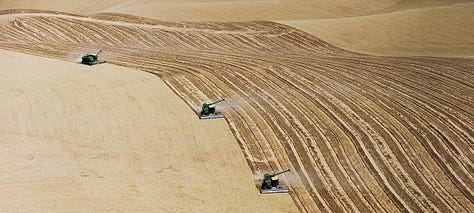


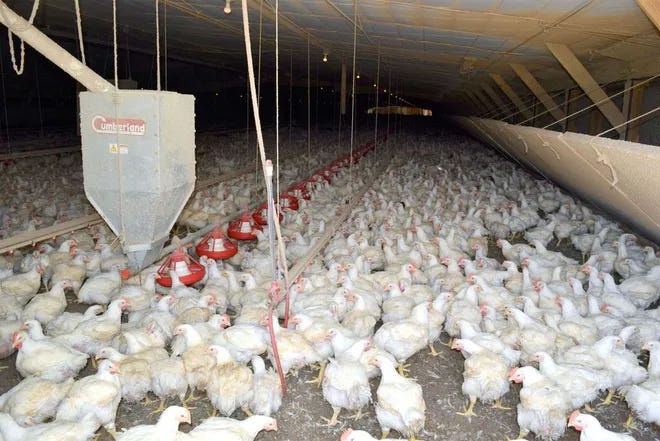
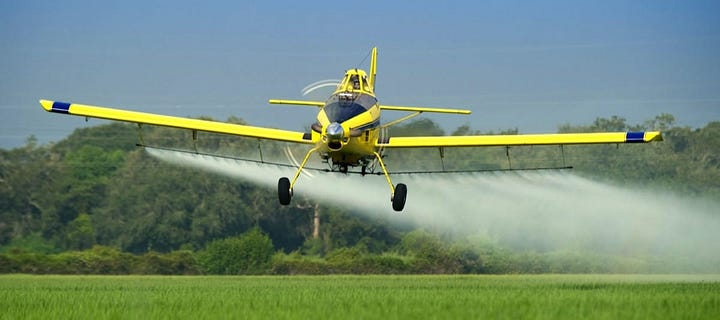
Introducing Agroecology
Agroecology is the application of ecology to agriculture. It considers concepts like competitive niches, energy flow, population dynamics, and biogeochemical cycles, as well as agriculture’s relationship to the environment. It’s ultimate hope is to design agroecosystems— self-sustaining food producing ecosystems in harmony with meaningful numbers of human consumers. To even talk about this right now feels like solarpunk fiction, but there are many stepping stones along the path.
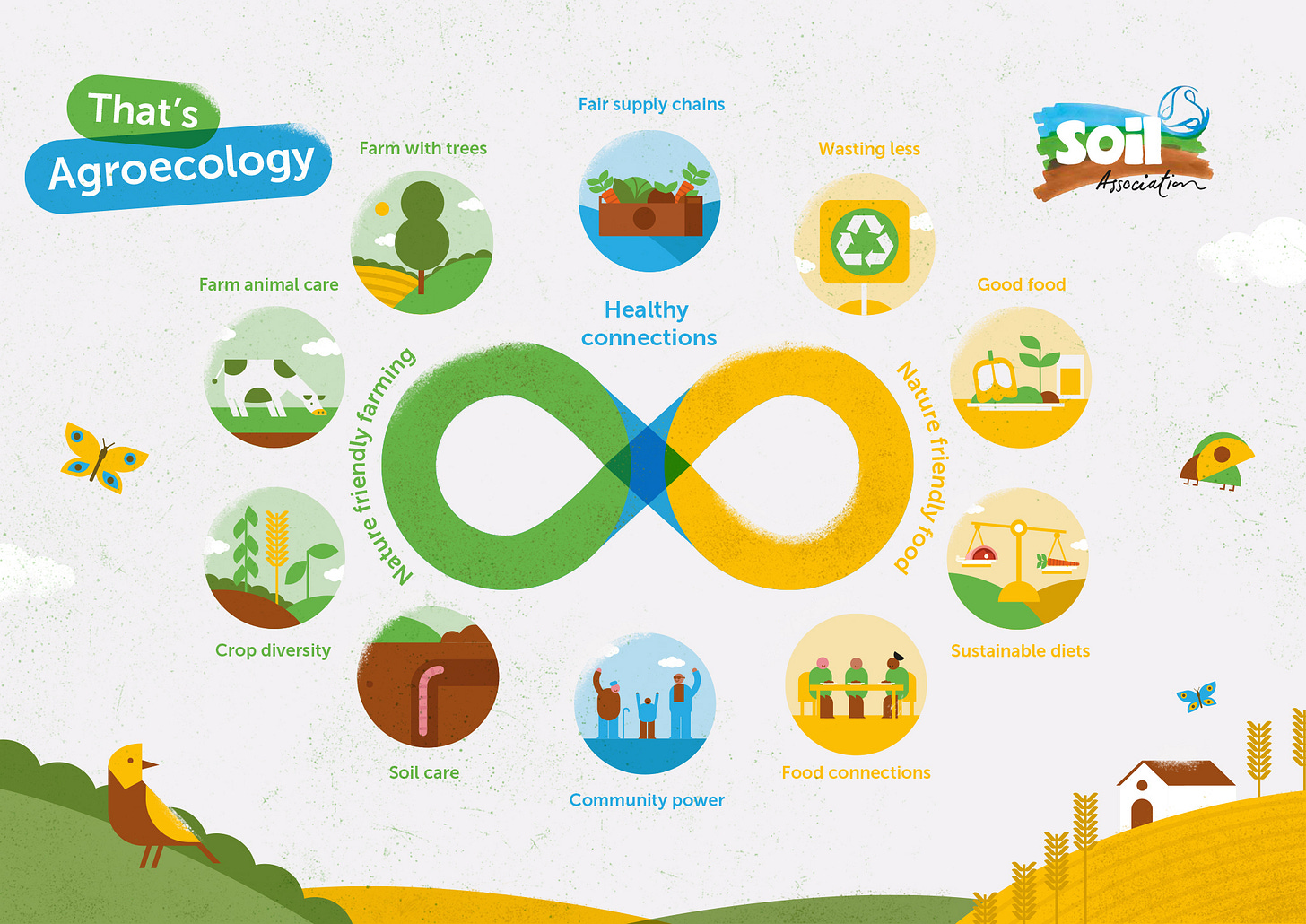
Incremental Agroecology
The cardinal truism in agroecology is: “diversity is good.” Principally, that means biodiversity, but also includes participation by a diverse set of stakeholders (both human and not, perhaps) in the agricultural process. The cardinal sin of agriculture is sterilization, and, so, most practices directly seek to counteract it.
No-till farming– It’s possible to grow crops without seriously disturbing the topsoil, which is home to a massively complex and delicate ecosystem of microbes, other microfauna, filamentous fungi, and roots. This biome provides many ecosystem services such as carbon/nitrogen fixation, pest control, water retention, and erosion management.
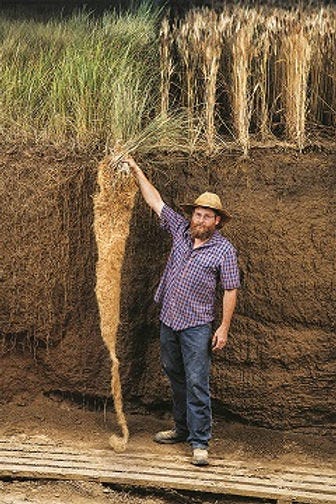
Kernza is a perennial wheat developed by the Land Institute. It does not require continual tilling or replanting like standard wheats, and is an effective carbon sink through its extensive roots and rhizome. Source. Organic farming/Crop Biologics– Like no-till farming, organic farming aims to preserve soil and/or livestock microbiomes, but by restricting certain kinds of chemical sterilization with pesticides and un-balancing fertilizers. There is a huge amount of investment activity in adding living microbes to the soil as Crop Biologics: plant probiotics and biostimulants, inoculants against disease, protection against pests, and soil-ammonia production. This could usher in a new golden age of organic farming.
Intercropping & Covercropping– Planting of two or more species of plants either simultaneously or subsequently, especially with nitrogen-fixing plants, like legumes, is already a well established, but not ubiquitous, practice.
Crop Genetic Diversity– The UN FAO identifies that diversity within species is at least as important as diversity between species. This limits crop blights that easily move through monocultures of genetically similar-or-identical plants and animals (e.g. Irish Potato Famine, various bird flus). Hybridization is one technique to increase intra-species genetic diversity.
Integrated farm management– IFM calls for farm practices that are data-driven and sustainable, but its hard for me to pull actionable principles from what seems like mostly jargon for conferences and government grants. One clear example is the food-feed system where farmers feed crop byproducts directly to livestock.
Regenerative agriculture– This powerful idea is to introduce species to a farm that provide ecosystem services like nitrogen cycling or seed spreading. This can be permanently or part of a rotation of crops. “Regen ag” is a major trend right now and worthy of its own treatment, but I worry that it has become primarily a greenwashing term to describe livestock ranching of ruminants, especially to meet demand for grass fed beef. I support some ranching, but it is only regenerative on certain land, at low stocking densities, and if compared to an industrial feedlot or degraded farmland; rather than compared to other options like agroforestry (discussed below).
Radical Agroecology
The most exciting applications of agroecology go beyond anti-sterilization and into the realm of permanent agriculture (permaculture)–a whole-systems design thinking approach to man-made food-producing (micro)ecosystems.
Plant Guilds– The main concept in permaculture is the companion planting of many types of plants that each provide ecosystem services to the group, such as nitrogen fixation, pollinator attraction, weed suppression, wind protection, soil drainage, pest mitigation, etc. At low densities, livestock can be added in. The result is emergent, with each crop thriving better than it would in isolation. There is a lot of great content in this area for home gardeners.
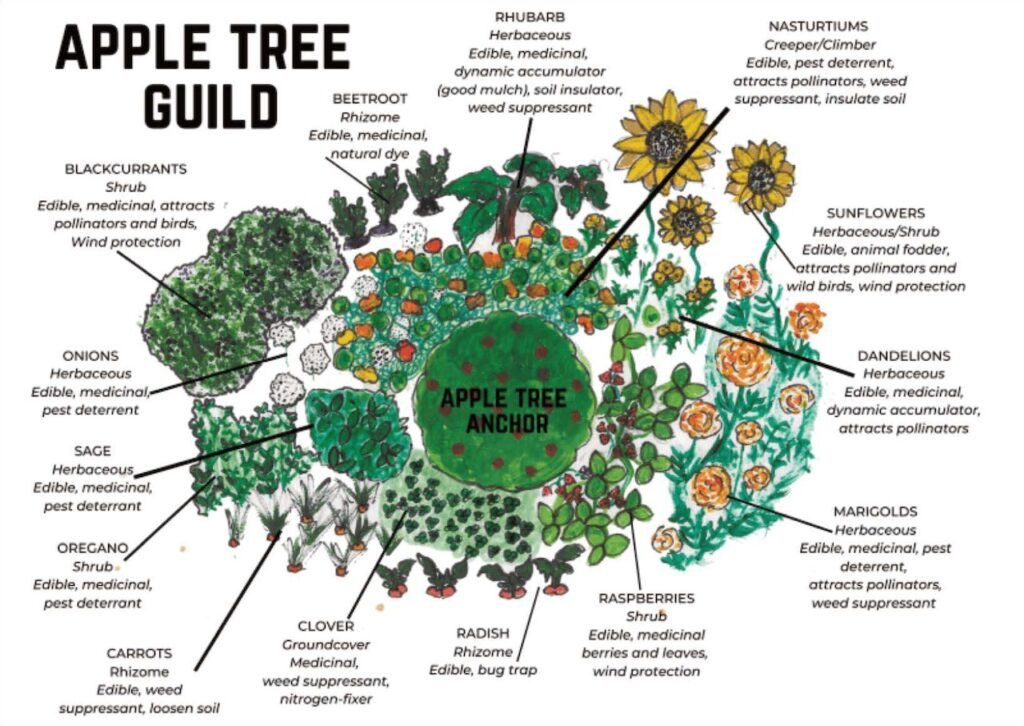
An example of a permaculture guild, design by Food Forest Design Minnesota. Source: Milkwood.net. Agroforestry- Permaculture is most powerful when perennial crops are used, especially in the case of forest gardens. This is a technique that may have been used extensively by indigenous people in South American jungles. Agroforestry is also a highly promising approach to urban agriculture.
Pixel cropping– This attempts to solve the hardest problem in permaculture, which is scale-up to the industrial farm context. Pixel cropping seeks to “automate agroecology” by developing small plant guilds that can be repeatedly copied onto an industrial farm and harvested efficiently using modern equipment.

Solar agriculture– Solar arrays can be used on farms to generate power while also providing shade for certain low-growing crops or livestock. If used in the right environment, solar panels can replicate the role of trees and allow for farm equipment to be used.
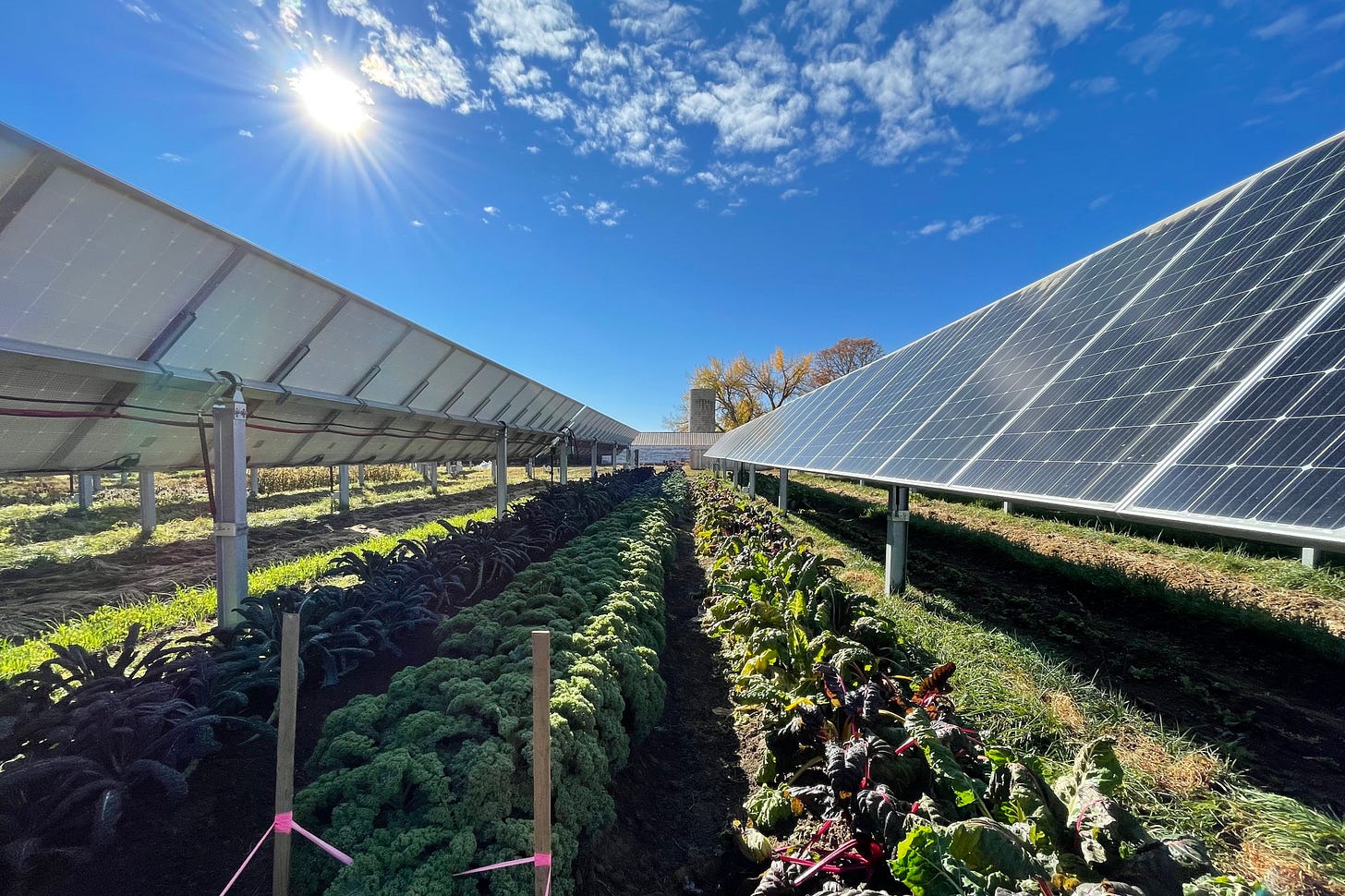
Source: NPR. Aquaponics– Hydroponics (growing crops in water) can, counterintuitively, use less water than soil-grown crops and reduce pest problems. By adding aquatic animals like fish, they naturally fertilize the plants. This can be done sustainably if the fish food is sustainable, like black soldier flies or algae. Note, this is not aquaculture, which is usually just the factory farming of fish, but might be used to improve aquaculture.
Extensive agriculture– The opposite of conventional, intensive farming, this approach aims to provide food at lower labor level and at lower yields per acre. Rather than describing specific practices, this is a fertile area for imagination of different farming or social systems. In particular, one where more people became involved in the food system again as gardeners or just conscious consumers. I’ve written that more home gardening could be a climate change solution. Urban agroforests, rural farm-ranch communities, Kibbutz or communal farms, wild foraging parties, or even robotics all provide outlines of what the agroecosystems of the future could look like.
Into the Headwinds
There are many headwinds to the widespread adoption of agroecology. The colonial pattern of industrial farming is deeply entrenched, and economic incentives don’t favor this kind of reform. But there are mechanisms that could provide tailwinds, too, like carbon credits, support of farmers markets or agrotourism, the rise of influential agro-individualists like Wendell Berry, or new types of farm cooperative loans. And as the science of crop genetics, microbiomics, and AI improves, there will be opportunities to apply them towards the aims of agrobiodiversity. For now, I will keep up my experiments at home and try to imagine what a future agricultural system utilizing these principle could look like. What do you see?

This is Fifth Industrial, a blog scouting emerging technologies and ideas for a regenerative economy and lifestyle. See the posts on the most impactful bioproducts, plant cell culture, cellular agriculture, mycelium materials, synthetic silk, microbiomics, deep space food, alt cheese, alt protein CPG, biophilia, agricultural innovation engines, longevity, egg sexing, mosquito-borne disease, wild animal welfare, climate victory gardens, and inflation versus depletion.
Thanks for reading. Please consider subscribing for free below.




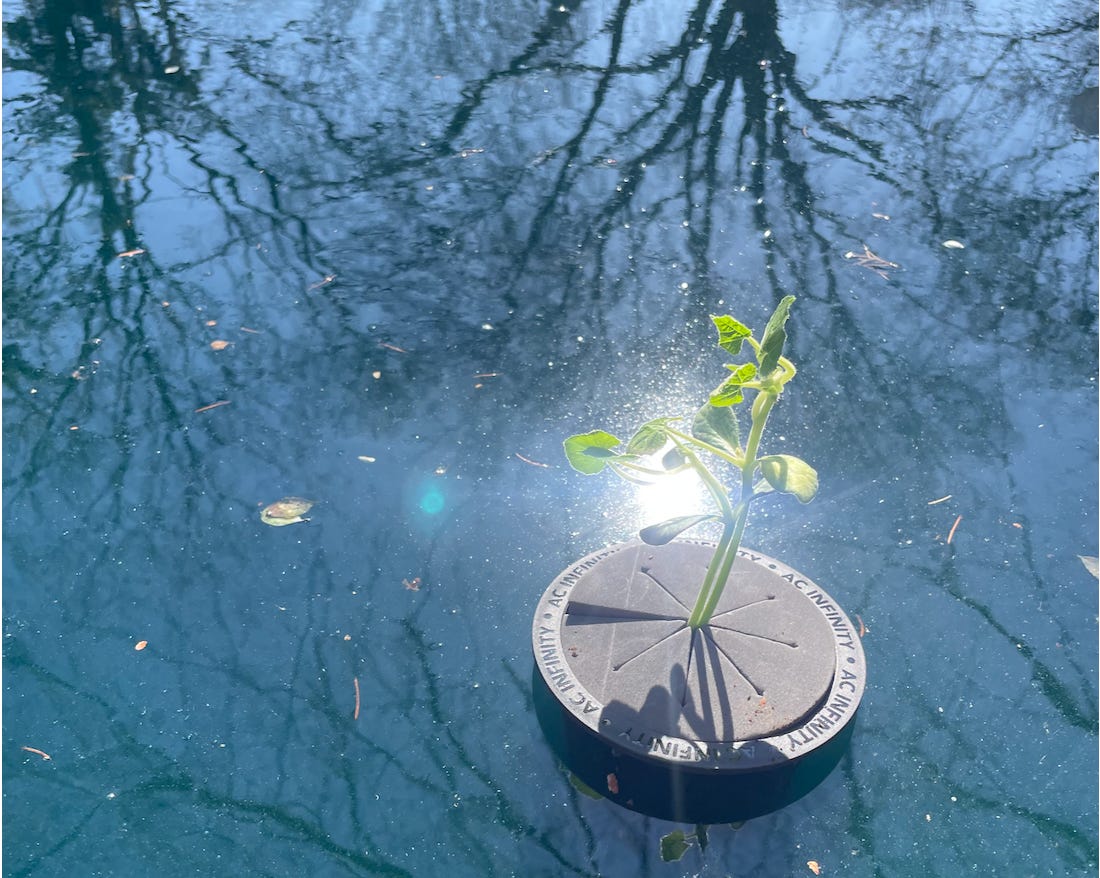
This was a great post Nate! It’s very good overview of how I think of the next gen of ag through permaculture. I’m keen to know what you think about how these types of permaculture techniques would inform CPG changes.
I could imagine more biodiversity and regionality of certain products. Certain varietals being sought after in their own right for different flavor characteristics. It could be far-fetched but I think we’re missing out on the richness of our food without taking some of the steps you’re suggesting as well.
Thanks again for the write up!